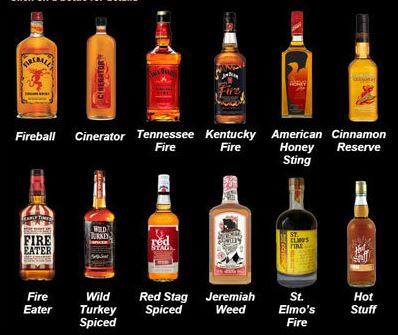I was just speaking to a bartender that wanted to know the difference between flavored whiskey and liqueur.
Hopefully, by now, most of us are aware that Southern Comfort (made so famous by Janis Joplin) is a liqueur, not a whiskey. It is “grain neutral spirit, sugar, and a fruit concentrate in which the dominant fruit is apricot.” (Chuck Cowdery) That means it is basically vodka with flavorings. Flavored whiskey, however, is a different animal.
By law (TTB regulations), Flavored Whiskey is described this way-
-Whisky flavored with natural flavoring materials, with or without the addition of sugar, bottled at not less than 30% alcohol by volume (60 proof)
-The name of the predominant flavor shall appear as part of the class and type designation, e.g., “Cherry Flavored Whisky”
-Wine may be added but if the addition exceeds 2½% by volume of the finished product, the classes and/or types and percentages (by volume) of wine must be stated as part of the class and type designation
A Liqueur/Cordial is defined this way-
-Flavored spirits product containing not less than 2½% by weight sugar, dextrose, levulose or a combination thereof made by mixing or redistilling any class or type of spirits with or over fruits, flowers, plants or pure juices therefrom or other natural flavoring materials or with extracts derived from infusions, percolation or maceration of such materials
Obviously, a flavored whiskey has more actual whiskey in it, but you will find there is a lot of leeway given.
Rock and Rye is also a “type” distinction under the Liqueurs/Cordials “class” of spirits . (As is Rock and Bourbon, Rock and Brandy, and Rock and Rum.)
It is defined this way-
Liqueur/Cordial with the predominant characteristic flavor of rye whisky made with not less than 51% on a proof gallon basis rye whisky, straight rye whisky or whisky distilled from rye mash, rock candy or sugar syrup and with or without the addition of fruit, fruit juices or other natural flavoring materials, bottled at not less than 24% alcohol by volume (48 proof). Wine may be used but if used may not exceed 2½% by volume of the finished product
Now, a lot of industry folks say that flavored whiskeys are meant to bring more women into the bourbon drinking community. Leaving that alone for a moment, I will say that more people will initially be drawn to sweeter flavors in any drink. When Americans come to try liquors for the first time they often prefer a mixed drink or cocktail because of the sweeter juice or soda involved. That’s only natural. Of course, the liquor involved in that mixed drink is most likely vodka, a flavorless and colorless spirit that lends itself to any flavor. Whiskey already has big flavors and those flavors don’t always play nicely with “pomegranate” and “Swedish fish”.
The growing market for flavored whiskey cannot be denied. Personally, it is not my taste, but I don’t have much of a sweet tooth, anyway. The idea that flavored whiskey is geared toward women is slightly offensive to me. Especially because most consumers of Red Stag and Southern Comfort are men. As an organizer of whiskey tastings, I can appreciate that some people would prefer a sweeter whiskey when first being introduced. It becomes almost a “gateway” or transitional whiskey. There’s not much nuance in Knob Creek’s Smoked Maple straight bourbon whiskey. You don’t have a hard time picking out the maple flavors. If it helps to bring more whiskey drinkers into the fold by transitioning a person into Knob Creek’s Single Barrel, I’ll be sure to promote it. Still wondering why the bottle of Knob Creek Smoked Maple says “straight bourbon” when there are flavors added, but that’s another story…

One thought on “What is the Difference Between a Flavored Whiskey and a Liqueur?”
Comments are closed.